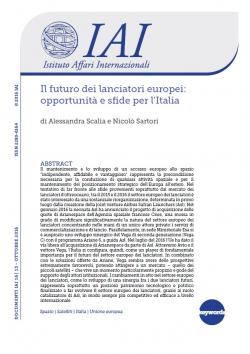Il futuro dei lanciatori europei: opportunità e sfide per l'Italia
An “independent, reliable and favourable” European access to space is a precondition for the conduct of space activities, while also contributing to Europe’s strategic positioning on the world stage. In order to face the challenges stemming from overseas competitors in the launcher market, between 2015 and 2016 the European launcher sector witnessed a significant reorganization, leading in particular to the creation of the Airbus Safran Launchers (ASL) joint venture. In January 2016, ASL announced the acquisition of Arianespace, whose market shares were held by the French Space Agency CNES (Centre national d’études spatiales), thereby concentrating European commercial and launching services in the hands of a single private stakeholder, ASL. Meanwhile, the ESA Ministerial Council promoted the development of a second generation Vega (Vega C) through its Ariane 6 programme, also spearheaded by ASL. In July 2016, the EU approved ASL’s acquisition of Arianespace. Through Avio and the Vega programme, Italy has therefore emerged as a key player in the future development of Europe’s launcher sector. In conjunction with Ariane, the Vega programme enjoys favourable market prospects due to its applicability to small satellites – a market in considerable expansion in light of its continued support from institutional actors. The emerging synergy between Vega C and Ariane 6 represents an important technological and political step forward for the European launcher sector. By acting as a catalyser, ASL holds out important potential to enhance the effectiveness and competitiveness of Europe’s launcher sector, both on the continent and in the international arena.
-
Details
Roma, IAI, October 2016, 10 p. -
In:
-
Issue
16|13
1. Il settore europeo dei lanciatori
2. Origini e specificità dell’industria italiana dell’accesso allo spazio
3. Europa e Stati Uniti a confronto: quali implicazioni per il futuro del settore?
4. Il futuro delle competenze italiane nel settore dei lanciatori: Vega come asset strategico
Conclusioni



